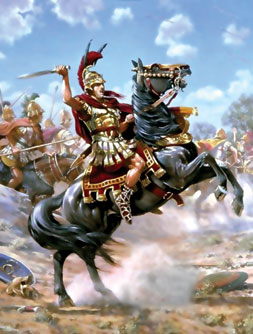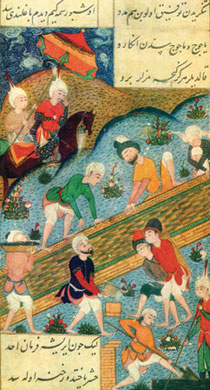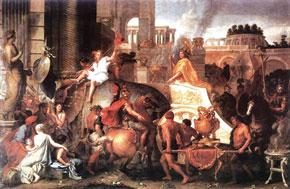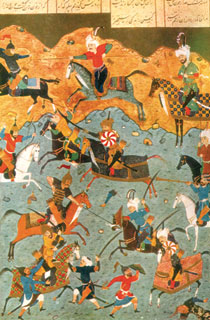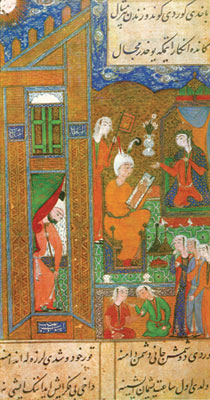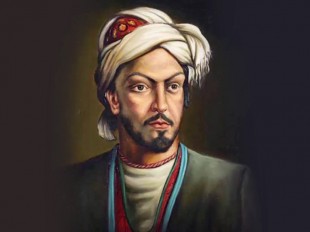Pages 80-84
by Seyfaddin G.Rzasoy
From the history of conquests
Young, excitable, stubborn and strong-willed, Alexander the Great (born 356BC) was a knight from birth. The passionate energy burning inside him continually impelled him towards conflict. His father’s plan of attack on the East captivated Alexander. He was totally persuasive in promoting his own and Greek Macedonia’s ambition to conquer the East.
Just 2 years after his proclamation as king (BC336), the 22-year-old commander marched to the East with his army of thirty thousand infantry and fifty thousand cavalry. He defeated a larger Persian army in the first battles of the campaign and followed a route to Egypt. He destroyed Tyre in Phoenicia, overcoming strong resistance. He went on to capture other Phoenician towns. Egyptian oracles regarded this man from Macedonia, who possessed such extraordinary power, as the sacred-mystical will of heaven. He was pronounced the "Master of the Universe" and the son of a deity. This was the reason behind Egypt’s capitulation without a fight. The most important battle was against Persia, the Greeks’ historical and eternal rival. The Persian king Darius III met Alexander Macedon with a massive and excellently-equipped army. From 334-331 BC, these powerful giants of the known world battled many times in three places. Finally, at the Battle of Gaugamela the Persian army was decisively defeated. The Greeks plundered the rest of the Persian towns. Alexander captured Central Asia and set off for India. But the long campaign had taken its toll on the army. It was steadily losing its unity. This was clear from battles against Indians. The exhausted army faced significant losses, its spirit was drained and there was an unwillingness to continue fighting. Alexander had to turn his forces back.
Alexander built the greatest empire of his time across a huge expanse, covering parts of three continents (Africa, Europe and Asia) and extending its boundaries as far as the Balkan Peninsula, Egypt and the River Indus. This empire united different races, languages, cultures and economies in one unique state. He adopted the life of an emperor in Babylon, which he made the capital of his empire. His trappings were decorated with jewels and precious stones. There was a political and mystical cult surrounding him. He was not only the bearer of political power, but he was also revered as a sacred-mystical ruler. Oracles proclaimed him to be a god. The life of Alexander - this king-idol – was not a long one. In 323BC Alexander became sick and died, aged 33 years. His body was transferred to Egypt and eventually placed in a golden sarcophagus in Alexandria, the town he had established.
The mystic 33
Alexander lived only 33 years, but those years were a lightning strike across world history. Countries and nations fell into his control before they had time to realise what was happening. It was as if it all happened in an instant. This ‘instant’ lasted 33 years. God grants people with life. Alexander was allocated just 33 years on Earth. But those 33 years of life were understood by others to be those of a divine king’s stay in this world. The idolization of Alexander arose from the mythical-sacred mentality of the people of that era. They believed that a king was a mediator between the profane world of people and sacred heaven. As a consequence, many countries and nations accepted Alexander’s arrival as the will of heaven.
There was a mysticism about his 33 years life. In eastern mystic beliefs the number ‘33’ had magical significance. It is interesting that in the legends of the Oghuz Turks, 33 was the border between life and death: it was necessary to reach 33 to arrive at the edge of the world of death and chaos and relocate to another world. Shaman Deli (wild) Domrul who took the spirit of dead people to the world of immortality, paid the Angel of Death, who accepts the spirit, 33 akcha for this service. Oghuz shamans sacrificed 32 souls and, by dying temporarily themselves as a 33rd soul (holding a ritual death), descended into chaos for a short time. The epic-mythic image of Alexander, who went to the world of death and chaos at 33, coincided with that of an ancient forefather - Khagan in the classic Oghuz ritual. Both of them, Alexander and Oguz Khagan - kings with a horn as a symbol of divinity - travelled in the Eastern epic tradition to the World of death, while still alive.
People like the Macedonian king are passionate, with stormy, wild and irresistible internal energy. They are born with extraordinary abilities and their qualities soon become apparent; they overtake all others to assume positions of power. Such people leave the world, as a rule, shortly after achieving their purpose.
There are other passionate rulers in history who have repeated Alexander of Macedon’s pattern of life. One of them was Shah Ismayil Khatai (1487- 1524), founder of the Azerbaijani Safavid state, one of the great luminaries of medieval history. He had a mystical genealogy. His grandfathers were leaders of a religious sect and extraordinary people. Ismayil became the leader of the official Safavid order when he was 7 years-old. At 13 (in 1501), he was proclaimed king and sat on Azerbaijan’s throne. He commanded the army from childhood, displaying the same exceptional valour and distinctive heroism in battle as Alexander. He also was regarded as the embodiment of divinity. During his 14-year reign he conquered 14 countries and expanded the territory of his empire to 86 million square km.
As with Alexander, Shah Ismayil Khatai accomplished his historic purpose in a short time. His death was also mystical. He liked lion hunting and went to the Baba Mountain in Sheki province. He was told that this mountain had magical power and prevented the hunting of lions. Nevertheless he killed a lion. Like Alexander, he contracted a high fever upon his return and died at the age of 38, after a short illness.
The image of Alexander created by Nizami
Alexander the Great is known as Alexander (Iskender) of Macedon in the East, including in Azerbaijan. One of the renowned Nizami Ganjavi’s (1141-1209) poems is the ‘Iskendername’. Nizami Ganjavi, a prominent figure in Eastern literature, advanced literature from the folktale style, bringing in completely new novel-style concepts and new aesthetic forms, founding a literary school that outlived him. The poem ‘Iskendername’ is in two parts. The first part, called ‘Sherefname’, concerns Alexander’s conquests, and the second part, the ‘Igbalname’ describes his scientific, philosophical and prophetic life.
In the ‘Sharafname’, Nizami touches on Alexander’s origins, depicting him as the real son of Philip, refuting all the Rome and Persian legends that say otherwise. There was an image of Alexander in eastern literature before Nizami. Working on his poem, Nizami avoided a tale-like description of the legends and myths about Alexander and created a new literary style. In doing so, he introduced a new type of human image to world literature. Nizami’s Alexander was a new image of a ruler, reflecting philosophical views on the harmony of nature, society and time itself. This image has a complicated structure. Nizami was a philosopher-poet. He considered not only about the life of one person or even one nation, but of the destiny of all humanity. Alexander is the last image of a king created by Nizami. From this point of view, Nizami’s all-embracing philosophical summary of human society, social relations, people and time, people and nature, science and society, people and God and much else, is brought together in his model of Alexander. It was not happenstance that, with this image, Nizami dispelled all other literary traditions about Alexander, and determined his literary future once and for all.
In Azerbaijani folklore
The historical, epic, chronicled, literary and other information about Alexander is preserved in people’s memories and enshrined in folklore. Thus there are multiple legends about Alexander in Azerbaijani folklore. In the manuscripts, Alexander differs from his historical prototype, having an image that reflects all the beauty of folk wisdom. In legend, Alexander has been called Alexander the Great, Horned Alexander, Alexander Zul-Qarnein (Two-Horned) and so on. According to the legends, the Caspian Gates of Derbend, the Gates of Shirvan, as well as the Alexander Gates, were built by him.
Mythbreaker and buried treasure
One legend has it that Alexander came to the Shirvan region crossing the Azerbaijani town of the Gates of Derbend. He climbed Mount Fit, where locals were afraid to tread and announced his arrival to the people. It used to be thought that people of the other world lived on Mount Fit and there was no way back for those who once went there. Alexander destroyed that belief. Alexander told people that he was king of the whole world. He constructed a castle on the mountain, buried all his treasure there, appointed guards and left Shirvan.
A magic horn, causing earthquake, treasure and defeat
After conquering the world, Alexander decided to occupy the Azerbaijani kingdom of Shirvan. Shirvan’s regent was a woman who lived in her Maiden Castle. She rejected Alexander’s ultimatum to capitulate. A battle began and Alexander’s army surrounded Shirvan. The queen sent poisoned snakes towards Alexander. He was powerless against them and offered to fight a Shirvanian face to face. The queen went out herself to fight. During the fight Alexander dropped his helmet and his horn become apparent. She knocked him down, grasping at his horn. His broken horn pierced the land. As all of Alexander’s strength was held in the horn, he became weak and was defeated. He buried his treasure in the land of Shirvan and left the country. People began to look for his treasure. But Alexander’s horn, broken and stuck in the earth, protected it. Whenever people began searching for the treasure, the horn shook and created an earthquake. Alexander’s horn was the reason for the frequent destructive earthquakes in Shemakha, in Shirvan.
Alexander and the Water of Life
Alexander the Great searched for the Water of Life to achieve immortality. He found the Fountain of Youth in Shirvan, Azerbaijan. He immediately took up some of the water in a golden cup and lifted it to drink. But a bird suddenly flew past, hitting the cup with its wing and knocking it out of his hand. Alexander was angry and went to kill the bird. Suddenly a voice told him that the bird was his saviour. The voice came from behind a rock. It told him that he was an old man, who had never wanted to die. ‘I found this fountain, drank of the water and became immortal. I was called Diri baba (elder) because I never died and have remained alive. After some time I lost all my relatives who had completed their term in this world. Now I am completely alone. Life is boring for me, but I can’t die. I sent that bird to you because I don’t want you to repeat my miserable experience. Alexander understood that eternal physical life is pointless. A person must live by doing good works in this world. Indeed, he lived for only 33 years. But in this short life he achieved things that carved his name forever into the cultural history of the world and the epic memories of nations. We still remember his name, his deeds, and he lives on in our memories in spite of the 2333 years that have passed. Our ancient Earth never forgets those who create history by good deeds.
About the author: Seyfaddin Rzasoy is Head of the Mythology Department of the Institute of Folklore in the Azerbaijani National Academy of Sciences and Deputy Editor-in-chief of the ‘Dede Gorgud’ scientific-literary journal.
Literature
1. G.Aliyev and B. Aslanov ‘Nizami Ganjavi’s Iskendername’: Literary translation from Persian to Azerbaijani (Baku, 1983)
2. Pirsultanli S.P. ‘The Folk Legends of Azerbaijani Turks’ (Baku, 2009)
3. Afandiyev P. ‘Azerbaijan folklore(literature)’ (Baku, 1992)
4. Yusifov X. ‘The Eastern Renaissance and Nizami Ganjavi’ (Baku, 1982)
5. Abbassov Y. ‘Nizami Ganjavi’s poem Iskendername’ (Baku, 1966)
by Seyfaddin G.Rzasoy
From the history of conquests
Young, excitable, stubborn and strong-willed, Alexander the Great (born 356BC) was a knight from birth. The passionate energy burning inside him continually impelled him towards conflict. His father’s plan of attack on the East captivated Alexander. He was totally persuasive in promoting his own and Greek Macedonia’s ambition to conquer the East.
Just 2 years after his proclamation as king (BC336), the 22-year-old commander marched to the East with his army of thirty thousand infantry and fifty thousand cavalry. He defeated a larger Persian army in the first battles of the campaign and followed a route to Egypt. He destroyed Tyre in Phoenicia, overcoming strong resistance. He went on to capture other Phoenician towns. Egyptian oracles regarded this man from Macedonia, who possessed such extraordinary power, as the sacred-mystical will of heaven. He was pronounced the "Master of the Universe" and the son of a deity. This was the reason behind Egypt’s capitulation without a fight. The most important battle was against Persia, the Greeks’ historical and eternal rival. The Persian king Darius III met Alexander Macedon with a massive and excellently-equipped army. From 334-331 BC, these powerful giants of the known world battled many times in three places. Finally, at the Battle of Gaugamela the Persian army was decisively defeated. The Greeks plundered the rest of the Persian towns. Alexander captured Central Asia and set off for India. But the long campaign had taken its toll on the army. It was steadily losing its unity. This was clear from battles against Indians. The exhausted army faced significant losses, its spirit was drained and there was an unwillingness to continue fighting. Alexander had to turn his forces back.
Alexander built the greatest empire of his time across a huge expanse, covering parts of three continents (Africa, Europe and Asia) and extending its boundaries as far as the Balkan Peninsula, Egypt and the River Indus. This empire united different races, languages, cultures and economies in one unique state. He adopted the life of an emperor in Babylon, which he made the capital of his empire. His trappings were decorated with jewels and precious stones. There was a political and mystical cult surrounding him. He was not only the bearer of political power, but he was also revered as a sacred-mystical ruler. Oracles proclaimed him to be a god. The life of Alexander - this king-idol – was not a long one. In 323BC Alexander became sick and died, aged 33 years. His body was transferred to Egypt and eventually placed in a golden sarcophagus in Alexandria, the town he had established.
The mystic 33
Alexander lived only 33 years, but those years were a lightning strike across world history. Countries and nations fell into his control before they had time to realise what was happening. It was as if it all happened in an instant. This ‘instant’ lasted 33 years. God grants people with life. Alexander was allocated just 33 years on Earth. But those 33 years of life were understood by others to be those of a divine king’s stay in this world. The idolization of Alexander arose from the mythical-sacred mentality of the people of that era. They believed that a king was a mediator between the profane world of people and sacred heaven. As a consequence, many countries and nations accepted Alexander’s arrival as the will of heaven.
There was a mysticism about his 33 years life. In eastern mystic beliefs the number ‘33’ had magical significance. It is interesting that in the legends of the Oghuz Turks, 33 was the border between life and death: it was necessary to reach 33 to arrive at the edge of the world of death and chaos and relocate to another world. Shaman Deli (wild) Domrul who took the spirit of dead people to the world of immortality, paid the Angel of Death, who accepts the spirit, 33 akcha for this service. Oghuz shamans sacrificed 32 souls and, by dying temporarily themselves as a 33rd soul (holding a ritual death), descended into chaos for a short time. The epic-mythic image of Alexander, who went to the world of death and chaos at 33, coincided with that of an ancient forefather - Khagan in the classic Oghuz ritual. Both of them, Alexander and Oguz Khagan - kings with a horn as a symbol of divinity - travelled in the Eastern epic tradition to the World of death, while still alive.
People like the Macedonian king are passionate, with stormy, wild and irresistible internal energy. They are born with extraordinary abilities and their qualities soon become apparent; they overtake all others to assume positions of power. Such people leave the world, as a rule, shortly after achieving their purpose.
There are other passionate rulers in history who have repeated Alexander of Macedon’s pattern of life. One of them was Shah Ismayil Khatai (1487- 1524), founder of the Azerbaijani Safavid state, one of the great luminaries of medieval history. He had a mystical genealogy. His grandfathers were leaders of a religious sect and extraordinary people. Ismayil became the leader of the official Safavid order when he was 7 years-old. At 13 (in 1501), he was proclaimed king and sat on Azerbaijan’s throne. He commanded the army from childhood, displaying the same exceptional valour and distinctive heroism in battle as Alexander. He also was regarded as the embodiment of divinity. During his 14-year reign he conquered 14 countries and expanded the territory of his empire to 86 million square km.
As with Alexander, Shah Ismayil Khatai accomplished his historic purpose in a short time. His death was also mystical. He liked lion hunting and went to the Baba Mountain in Sheki province. He was told that this mountain had magical power and prevented the hunting of lions. Nevertheless he killed a lion. Like Alexander, he contracted a high fever upon his return and died at the age of 38, after a short illness.
The image of Alexander created by Nizami
Alexander the Great is known as Alexander (Iskender) of Macedon in the East, including in Azerbaijan. One of the renowned Nizami Ganjavi’s (1141-1209) poems is the ‘Iskendername’. Nizami Ganjavi, a prominent figure in Eastern literature, advanced literature from the folktale style, bringing in completely new novel-style concepts and new aesthetic forms, founding a literary school that outlived him. The poem ‘Iskendername’ is in two parts. The first part, called ‘Sherefname’, concerns Alexander’s conquests, and the second part, the ‘Igbalname’ describes his scientific, philosophical and prophetic life.
In the ‘Sharafname’, Nizami touches on Alexander’s origins, depicting him as the real son of Philip, refuting all the Rome and Persian legends that say otherwise. There was an image of Alexander in eastern literature before Nizami. Working on his poem, Nizami avoided a tale-like description of the legends and myths about Alexander and created a new literary style. In doing so, he introduced a new type of human image to world literature. Nizami’s Alexander was a new image of a ruler, reflecting philosophical views on the harmony of nature, society and time itself. This image has a complicated structure. Nizami was a philosopher-poet. He considered not only about the life of one person or even one nation, but of the destiny of all humanity. Alexander is the last image of a king created by Nizami. From this point of view, Nizami’s all-embracing philosophical summary of human society, social relations, people and time, people and nature, science and society, people and God and much else, is brought together in his model of Alexander. It was not happenstance that, with this image, Nizami dispelled all other literary traditions about Alexander, and determined his literary future once and for all.
In Azerbaijani folklore
The historical, epic, chronicled, literary and other information about Alexander is preserved in people’s memories and enshrined in folklore. Thus there are multiple legends about Alexander in Azerbaijani folklore. In the manuscripts, Alexander differs from his historical prototype, having an image that reflects all the beauty of folk wisdom. In legend, Alexander has been called Alexander the Great, Horned Alexander, Alexander Zul-Qarnein (Two-Horned) and so on. According to the legends, the Caspian Gates of Derbend, the Gates of Shirvan, as well as the Alexander Gates, were built by him.
Mythbreaker and buried treasure
One legend has it that Alexander came to the Shirvan region crossing the Azerbaijani town of the Gates of Derbend. He climbed Mount Fit, where locals were afraid to tread and announced his arrival to the people. It used to be thought that people of the other world lived on Mount Fit and there was no way back for those who once went there. Alexander destroyed that belief. Alexander told people that he was king of the whole world. He constructed a castle on the mountain, buried all his treasure there, appointed guards and left Shirvan.
A magic horn, causing earthquake, treasure and defeat
After conquering the world, Alexander decided to occupy the Azerbaijani kingdom of Shirvan. Shirvan’s regent was a woman who lived in her Maiden Castle. She rejected Alexander’s ultimatum to capitulate. A battle began and Alexander’s army surrounded Shirvan. The queen sent poisoned snakes towards Alexander. He was powerless against them and offered to fight a Shirvanian face to face. The queen went out herself to fight. During the fight Alexander dropped his helmet and his horn become apparent. She knocked him down, grasping at his horn. His broken horn pierced the land. As all of Alexander’s strength was held in the horn, he became weak and was defeated. He buried his treasure in the land of Shirvan and left the country. People began to look for his treasure. But Alexander’s horn, broken and stuck in the earth, protected it. Whenever people began searching for the treasure, the horn shook and created an earthquake. Alexander’s horn was the reason for the frequent destructive earthquakes in Shemakha, in Shirvan.
Alexander and the Water of Life
Alexander the Great searched for the Water of Life to achieve immortality. He found the Fountain of Youth in Shirvan, Azerbaijan. He immediately took up some of the water in a golden cup and lifted it to drink. But a bird suddenly flew past, hitting the cup with its wing and knocking it out of his hand. Alexander was angry and went to kill the bird. Suddenly a voice told him that the bird was his saviour. The voice came from behind a rock. It told him that he was an old man, who had never wanted to die. ‘I found this fountain, drank of the water and became immortal. I was called Diri baba (elder) because I never died and have remained alive. After some time I lost all my relatives who had completed their term in this world. Now I am completely alone. Life is boring for me, but I can’t die. I sent that bird to you because I don’t want you to repeat my miserable experience. Alexander understood that eternal physical life is pointless. A person must live by doing good works in this world. Indeed, he lived for only 33 years. But in this short life he achieved things that carved his name forever into the cultural history of the world and the epic memories of nations. We still remember his name, his deeds, and he lives on in our memories in spite of the 2333 years that have passed. Our ancient Earth never forgets those who create history by good deeds.
About the author: Seyfaddin Rzasoy is Head of the Mythology Department of the Institute of Folklore in the Azerbaijani National Academy of Sciences and Deputy Editor-in-chief of the ‘Dede Gorgud’ scientific-literary journal.
Literature
1. G.Aliyev and B. Aslanov ‘Nizami Ganjavi’s Iskendername’: Literary translation from Persian to Azerbaijani (Baku, 1983)
2. Pirsultanli S.P. ‘The Folk Legends of Azerbaijani Turks’ (Baku, 2009)
3. Afandiyev P. ‘Azerbaijan folklore(literature)’ (Baku, 1992)
4. Yusifov X. ‘The Eastern Renaissance and Nizami Ganjavi’ (Baku, 1982)
5. Abbassov Y. ‘Nizami Ganjavi’s poem Iskendername’ (Baku, 1966)
